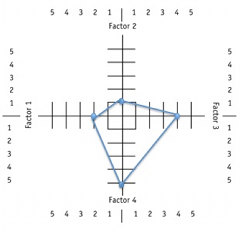Cobweb Matrix
- Objective: To identify, understand and rank contributing factors driving an issue or problem.
- Materials/Preparation: Flipchart paper, pens, markers.
- Participants: This exercise can be done with staff, partners as well as in the community. The Inner Spaces Outer Faces Initiative recommends a group of 10-15 participants for this exercise.
Steps
Following introductions, the facilitator asks participants to identify an issue they would like to explore.
Once identified, participants identify factors they think contribute to the issue, and prioritize 4-6 factors.
The 4-6 factors are placed in a list. The facilitator then draws a cob-web matrix on a piece of flipchart paper, and adds 5 layers of ‘web’ to indicate levels of support that exist in the community.

Related Tools
View more tools on:
- Preliminary Foundations: Broader Context
- Aspirations and Strategic Interests
The facilitator then asks participants to discuss what levels of strength for each factor, with level 1 being ‘very little strength’ and 5 being ‘the most strength.’ Each level is then marked on the cobweb matrix with a dot.
After the drawing is completed, the group discusses the diagram, what it shows and what could be done with the knowledge gained from the exercise.

Some questions that may assist the conversation include:
- What have we learned about the causes of the problem, or the factors contributing to the situation?
- What type of action could be taken to address the issue? Who should take the action? What would be the benefits of addressing this issue? Is this something your community feels is important to take action on?
- Which problems or opportunities are easier or harder to address?
- Are the problems/opportunities similar for women and men? What is the difference and what accounts for this difference?
- How can opportunities for women and men be made more equal? What needs to be done? Who needs to be involved?
Finally, the team saves the exercise and marks the date, participants and location of the exercise to return to at a later time to see how the situation may change within that community or context.
Follow-up
Returning to a previous matrix, participants may discuss how the situation has changed. Participants may then mark changes with new rankings of the same factors for the issue.
Resources
- CARE and ICRW (2006). Walking the Talk. Inner Spaces, Outer Faces Initiative: A Gender and Sexuality Initiative.
